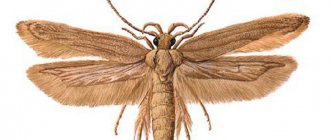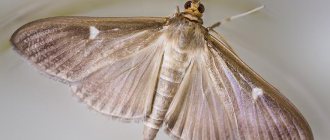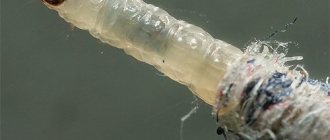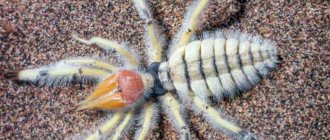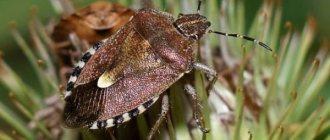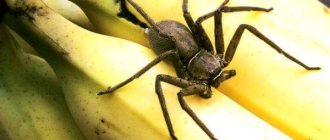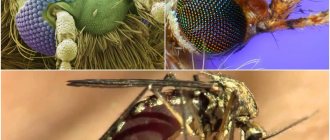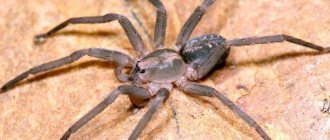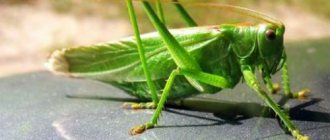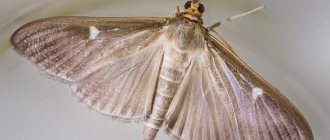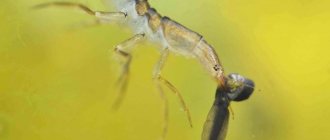Appearance and features
If we compare moths with flies, mosquitoes, cockroaches and other pests that like to live in people’s houses and apartments, then they are less dangerous. It does not bite humans and does not spread infections, but it can cause irreparable damage to household items, furniture, and destroy food supplies.
The insect belongs to a large group of the order Lepidoptera. There are several thousand species of moths in total. They are all very similar in appearance , rather inconspicuous gray butterflies. They can reach 5–9 mm in length. Only adult individuals have wings, but they fly poorly.
For the normal functioning of this insect, food is necessary, preferably of natural origin. Each butterfly finds its own source of nutrients. For this reason, the name of an insect is determined by what it eats.
Moths parasitize human homes and also trees. Based on this, several types of household pests are distinguished:
- wardrobe;
- fur coat;
- furniture;
- apple;
- barley
The life cycle of an insect directly depends on what it eats. The food species lives the least because it has a more nutritious diet. This variety reproduces much faster . After reaching 1–3 months of life, the food butterfly is ready to reproduce. The dress species reaches maturity and can reproduce after six months of life.
Mosquitoes and carpet beetles
Carpet beetles are small brown insects, barely 3.5 mm long. Pest beetles prefer to feed on organic waste from pets and insects. In human homes, such insects destroy paper, clothing, leather goods, book binding, and some wardrobe items. Pests can go undetected for a long time, living behind baseboards and feeding on leftover debris. Their eggs are also found in cereals and dry herbs.
Some bugs of this species prefer museum exhibits. But in any case, such insects pose a danger, as they destroy food and household items, clothing. In addition, beetles also cause harm directly to humans. Thus, they are carriers of helminth eggs and pathogenic microbes. Bugs are removed using insecticides.
Not everyone knows that mosquitoes breed outside human habitation. They lay eggs on the street and fly up to a person to feed on blood. Moreover, only females act this way. For males, flower nectars are suitable food. Mosquitoes cannot live without moisture, so they are most often found in places where there is enough water: near bodies of water, in basements, damp houses.
Types of moths and their reproduction
Nowadays, biologists count almost 40 families of common moths, most of them living in our climatic conditions. The most voracious and dangerous for our homes are:
- furniture - prefers natural furniture and eats upholstery materials;
- clothes - eats mainly products made from natural wool;
- grain - lives in the kitchen and feeds mainly on various types of cereals.
Moths have an excellent appetite, they eat a lot and reproduce quickly. Insects that live in natural conditions feed on plant fruits, nuts, seeds, grain, down and feathers of birds, and animal hair. Their life cycle always depends on weather conditions and the time of year.
At home, moths live in more comfortable conditions and, with a good food source, can reproduce much faster. With every opportunity, they penetrate into a person’s home, so they are widespread everywhere. In such an environment, butterflies have no natural enemies, for example, birds that eat them, so moths live and reproduce there quietly.
How moths reproduce
The development of moths, like butterflies, occurs in several stages:
- Egg.
- Larva (caterpillar).
- Doll.
- Adult butterfly.
The average lifespan of a butterfly is about 3 weeks. Some types of moths live only a few days. During this short period of time, the female manages to lay from 40 to 200 eggs, from which white translucent larvae hatch a week later. As soon as the caterpillar is born, it begins to actively feed and form a spindle-shaped cocoon from the surrounding nutrient medium. It is while in the larval stage that the moth causes the main damage. After a month and a half, the larva pupates, after which a butterfly emerges from the pupa. An adult individual begins to reproduce offspring literally from the first days of life: it lays eggs in dark, secluded places and soon dies.
Thus, under proper conditions, moth reproduction is an ongoing process. The duration of the development cycle depends on the type of insect, living conditions and varies from 1 month to 2.5 years.
What does the parasite eat?
The answer to this question is simple; it all depends on the type of pest. It is worth knowing that an adult eats practically nothing. Only larvae laid by an adult can actively feed. If the food source is suitable for them and there is a sufficient amount of it, the larvae gain weight and size very quickly. When the larva has already fattened well, it begins to pupate and spends about 2 months in a cocoon state. After this, an insect appears that resembles an ordinary gray moth.
Those individuals that find themselves inside the living space in the larval state continue to actively feed at any time of the year. In the natural environment, pupated larvae hibernate and sleep until spring.
Domesticated moths thrive in a comfortable environment. For example, a dress type takes up residence in a closet or chest of drawers. Valuable protein necessary for its full development is contained in woolen products. It is easily absorbed in her body, giving the cells the necessary energy. In addition to woolen products, moths can feed on clothing containing wool and synthetics. If the insect eats natural fibers intertwined with synthetic ones, then its development will slow down.
This species of moth also loves to eat natural fur coats, sheepskin coats, and carpets. Most often, they choose not very fresh things , because they prefer those that have been worn for a long time. Clothes moths also eat cotton clothing and silk upholstery in furniture. Sometimes she can switch to food and eat cereals, dry bread, and cereals.
Food moths, unlike clothes moths, cannot feed on clothes in the closet. She only eats food. It cannot cope with fabric or fur fibers, since the digestive juices of this type of insect do not contain the necessary enzymes. Food moths eat almost the same foods as humans.
Moth, away - how to get rid of parasites?
If the most unpleasant thing has already happened, and butterflies are circling in the kitchen, and caterpillars are stirring in the cereal, then you shouldn’t be too upset, it’s better to tune in to the positive and arm yourself with the knowledge of how to remove food moths competently and quickly.
First of all, we find out what specific type lives in the house. At the same time, without a drop of regret or doubt, we throw out all the spoiled products. Often, products are simply heated in the oven for half an hour at a temperature of 60 degrees, but not everything can be heat treated. We temporarily move everything that remains untouched by the pest into another room. The fact is that you will need to thoroughly treat the infected area, for which poison is used, which should not get into the food.
Choosing a remedy for food moths:
- Aerosol – Armol, Raptor, Antimol, Combat, etc.
- Repellent - fir oil, the same lavender, citrus zest and oils, bay leaves, garlic cloves, etc.
- Traps for food moths - special ones, as well as adhesive tapes for flies.
Aerosols are good because they can be sprayed onto various surfaces, be it metal, glass, plastic or wood. This product is very effective because it contains an insecticidal component that has a detrimental effect on insects. But repellents are not capable of this, but they are good in the sense that they repel the adult individual and its larvae and reduce their activity.
The Aeroxon food moth trap is very popular. Its secret is that the adhesive surface is treated with a special composition that attracts moths by smell. The sticky surface does not dry out for a long time, turning into real traps for insects. And to be on the safe side, it is better to additionally destroy all flying individuals manually - with a fly swatter, newspaper, or palms, so that they do not hide in a safe place for a while.
The second, but no less effective remedy is traps from the Swiss company SWISSINO (Food Moth Trap). They act absolutely safely (thanks to the natural active ingredient), but leave no chance for insects.
Having determined for yourself an effective scheme for how to get rid of food moths, do not forget that this insect quickly adapts if it is poisoned with the same means. For example, if there was a repellent herb in the cupboard at the time the product contaminated with larvae entered it, then the hatched butterflies will no longer be afraid of it. So it is necessary to fight this scourge at all stages of its development.
Some mistakenly believe that the most important thing is to destroy the larvae, but they will be laid again by flying individuals, and within a week a new replacement will be ready. Only a comprehensive and timely approach will ensure the desired result!
Are moths dangerous for humans?
Even if the house is perfectly clean and tidy, this will not prevent moths from appearing in the living area. For example, food moths can come from food purchased at the store. This is especially true for cereals, so when you bring them home, you should always check the integrity of the packaging and for the presence of food moth larvae.
Butterflies lay tens and hundreds of eggs , after which larvae soon appear and begin to actively feed on things or food. They are located near the egg laying site and begin the destructive process there.
You can easily notice lumps of cobwebs and empty cocoons after the life of the insect. If such signs are noticed, it is necessary to immediately take urgent measures to eliminate the pest.
Unlike other dangerous insects, this pest does not cause infection , but causes great damage to household life, destroying things, furniture, and many types of food.
Such food is not dangerous to humans, but it becomes contaminated, so it is best to throw it away. It is very important to identify moths in a timely manner and protect your home from this dangerous pest.
Moth: a lover of women's fur coats or an unpredictable household pest?
The house moth is a keratophagous insect.
It feeds on substances contained in fur and wool, and they are based on keratin. The special structure of the stomach, which produces a sufficient amount of acid, helps moths digest it. Despite the fact that a large number of species of this pest live in nature, most often we encounter only one species – the dress moth. We all witnessed how our mothers and grandmothers fought this insect using folk remedies.
Fortunately, manufacturers now offer in stores a huge number of chemicals that can remove the pest and prevent its appearance in homes, dachas, and production workshops.
How to recognize poplar moth by sight
He will tell you what a poplar moth looks like - photo. If you strain your memory, these are the kinds of insects that accumulate on lighting fixtures, near TVs, and behind curtains during the June “downfall.” Of course, the abundance of insects negatively affects the sanitary condition of the home. Its presence is especially unacceptable if there are small children or allergy sufferers in the house.
Interestingly, apart from irritation and discomfort, poplar moths do not cause physical harm. That is, it does not spoil food, does not make bald spots in fur coats, does not gnaw holes in woolen items - there is nothing “edible” for insects of this type in the house/apartment. Well, then she is attracted to living quarters. Everything is very simple - it is convenient for her to reproduce in a home environment. Despite the fact that the life cycle of an adult is only 72 hours, during this period the female manages to lay eggs three times, from which larvae instantly form and then turn into mature butterflies. Clutches of poplar moth eggs can be found in places loved by its other “brethren” - in bags of cereals, flour, dried fruits, etc.
Adult poplar moth
It is worth noting that, although this insect does not spoil things and products in the house, but, as stated above, it is capable of penetrating electrical lighting devices, as well as televisions, computers, etc. As a result, the devices may not function properly, or even completely fail.
Favorable conditions for kitchen pests
Do not neglect the danger of moth infestation in your apartment. It is enough to bring a larva in a bag, or a butterfly to fly in from a ventilation shaft, and voracious pests will breed in the house. To prevent moths from multiplying, it is necessary to create uncomfortable conditions for them in the kitchen. For the development of larvae, the following is necessary:
- Food source. If there is not an abundance of suitable food, insects will not be able to reproduce. They need flakes, flour, cereals, nuts. In extreme cases, dried herbs will do.
- A shelter sheltered from light and fresh air. Pests do not breed on open shelves - it is too light there. They settle in tightly closed cabinets and closets, where they are not disturbed by sunlight and air movement. In such places, moths actively reproduce. Pests like damp and dimly lit kitchens.
- The presence of rich and pungent aromas. Some smells repel moths and force them to move away from their source. This is the aroma of citrus, lavender, eucalyptus, vinegar and tobacco.
The following measures help prevent the proliferation of larvae in the kitchen:
- Having bought products in a store, carefully inspect those that contain moths (cereals, flour, spices, dried fruits). If there is no infestation, they are placed in tightly closed containers or linen bags, since moths easily penetrate cardboard boxes and plastic bags. Some housewives first rinse the bags in a saturated salt solution and then dry them.
- Kitchen cabinets are often ventilated and wiped with a cloth soaked in vinegar.
- Lavender, orange or tangerine peels are placed on the shelves.
- You should not stock up on cereals, flour, or nuts. The longer these products are stored, the higher the likelihood of moths appearing in them.
Why are these insects dangerous?
What is the harm from these insects? First of all, food moths settle in the kitchen and people simply do not notice them. But very soon the flying individuals find small cracks in the kitchen cabinets and begin to penetrate the cereals.
They live there quite well for some time and constantly lay eggs. Later, larvae emerge from the eggs, and then adults. As a result of this life cycle, a lot of dead larvae and skins remain in the cereals. Naturally, you can’t eat food after this. Even sifting and washing the particles, which are subsequently dried, will not help.
If you do not take any active steps to remove pests, they will begin to increase in number.
The worst thing is that moths can harm not only cereals, but absolutely any product. This may include: chocolate, tea, nuts, dried fruits, jam, salads, etc.
In addition, they climb on tables and dishes and can spread various infections. If there are moths in the house, then the dishes must be washed before eating. This applies not only to plates, cups and spoons, but also to all the cutlery you use.
The harm to humans lies in the fact that moths bring discomfort along with them. She constantly flies around the apartment, falls into plates and crawls everywhere she can. In such circumstances, inviting friends for a cup of tea is out of the question.
So, let's summarize. Moths can harm humans in the following ways:
- Spoil food
- Contaminating dishes
- Cause discomfort
How to prevent larvae from breeding in clothes
No matter how pests enter the house, they must not be allowed to multiply massively in cabinets and upholstered furniture. The following precautions will help protect your clothes:
- The purchased woolen item is carefully inspected inside and out. Check the seams carefully; larvae often hide in them.
- When buying a fur hat and fur coat, they are carefully checked for moth damage, even if the purchase is made in an expensive store. In sunny weather, a new item is hung on the balcony to air and left for 3 days.
- Woolen and fur items are stored in covers that are pre-sprayed with insecticidal aerosol preparations.
- Before long-term storage, items are cleaned and dried. Dirty clothes should not be placed in a closet; the smell attracts moths.
- Sprigs of lavender or orange peels, which are laid out on closet shelves, are good at repelling insects. They should be replaced with fresh ones more often. You can put an open bottle of orange or lavender oil in the closet.
- To preserve things, some housewives wrap them in newspapers, since moths cannot stand the smell of printing ink. A good deterrent is cigarettes placed in your pockets. But their smell remains for a long time and many people do not like it.
- To destroy the larvae and eggs, the clothes are frozen. To do this, in frosty weather it is left on the balcony for 2-3 days. Any moth dies.
- To kill moths in small woolen items (hats, scarves, socks), they are placed on hot radiators.
How to get rid of food moths forever
In the kitchen
After removal procedures, be sure to treat the places where it lived. Wash cabinets where insect-infected products were located with warm soapy water, then with clean water. All cracks and grooves are coated with table vinegar using a thin brush. After this, the cabinet remains open until it is completely dry.
To prevent harmful insects from infesting your kitchen, store groceries in bins or containers with tightly closed lids. If you have to store food in plastic bags, they must be well tied.
In cereals
If moths have severely affected cereals, they should not be eaten. If a small amount of food is damaged, you can try sorting it out, then dry it for 15 minutes in the oven at 60 °C or in the microwave.
On cabbage
A common pest worldwide is the cabbage moth. After several bites by the insect, the head of cabbage cannot be stored and begins to quickly deteriorate. The pest infects the plant while still in the beds.
Work to combat insects is carried out in a complex manner.
- The remains of the harvest are carefully plowed. Because pupae remain on them and on the weeds for the winter, and after plowing they will not be able to get out.
- Make sure that weeds do not spread. If more than 10% of the crop is affected or there are more than 4 caterpillars on one bush, treat with insecticides.
- The most effective means of controlling garden pests are Entobacterin, Lepidocid, Bitoxibacillin.
